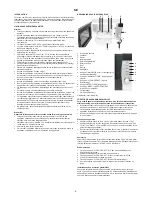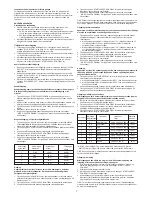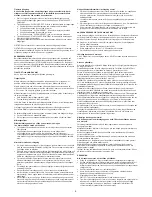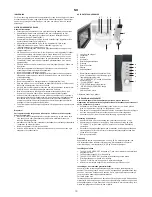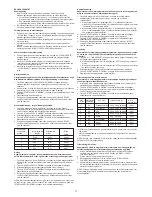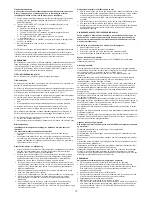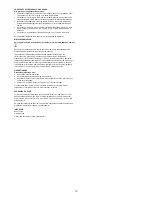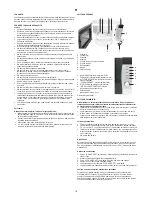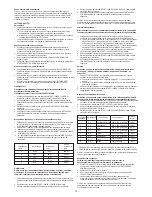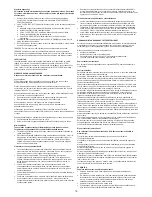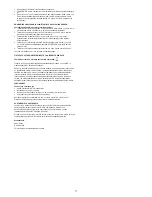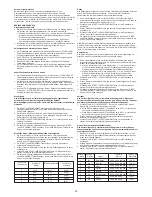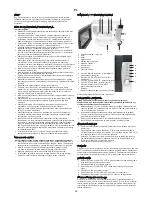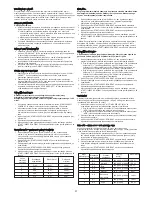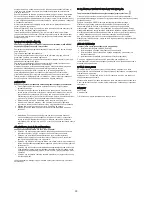
20
21
Timed cooking
You can set the appliance to start cooking at a given time. It is important to
ensure that the clock on the appliance is correctly set (see the section Setting
the clock above) when using this function.
1. Set the programme/programmes normally (as instructed in the sections above),
but do not commence cooking by pressing the "START/+30 SEC/CONFIRM"
button.
2. Press the "CLOCK/PRE-SET" button. Now set the required time for the cooking
to begin:
a. The display shows the actual time and the hour digits will begin to flash.
b. Turn the selector button to set the hours.
c. Press the "CLOCK/PRE-SET" button; the minute number will start to flash.
d. Turn the selector button to set the minutes.
e. Press the “CLOCK/PRE-SET” button again, if you wish to alter the starting
time.
3. Press the "START/+30SEC/CONFIRM" button to complete the task. The display
switches to showing the clock.
4. When the selected time is reached, two beeps are sounded and the oven starts
the cooking.
IMPORTANT! This function should not be used together with the defrosting
programmes.
IMPORTANT! There is no visible indication on the appliance that it has been preset
to automatically start at any given time. Hence, you should make sure that others do
not inadvertently remove the food or replace it with other food.
CHILD SAFETY LOCK
The child safety lock prevents small children from using the appliance. The
appliance cannot be operated as long as the child safety lock is active. The child
safety lock is activated by holding the "STOP/CLEAR" button down for 3 seconds.
A long beep will be heard, and the display shows a lock symbol. The child safety
lock is deactivated by holding the "STOP/CLEAR" button down for 3 seconds. The
key symbol will then disappear from the display.
TIPS FOR FOOD PREPARATION
When preparing food in the appliance, the following basic rules apply:
Cooking time
Smaller quantities of food cook more rapidly than large quantities. If the amount of
food is doubled, the preparation time must correspondingly be more than doubled.
Small pieces of meat, small fish and chopped vegetables cook more quickly than
large pieces. For the same reason, it is recommended that if, for example, you wish
to make goulash, stews or similar, the meat be cut into pieces no bigger than 2 x 2
cm.
The compactness of the food is also very important for the cooking time. The more
compact the food is, the longer it takes to cook.
• Whole joints require a longer cooking time than stewed dishes.
• A joint requires a longer time than a dish using minced meat.
The colder the food, the longer the cooking time needs to be. Food at room
temperature will therefore cook faster than food from a fridge or freezer.
When cooking vegetables, the cooking time depends on the freshness of the
vegetables. Therefore check the condition of the vegetables, and add or deduct a
little time accordingly.
The short cooking time when using a microwave oven means that the food does not
overcook.
4. If required, a little water can be added.
5. When cooking fish and vegetables, you only need to use the minimum of water.
Microwave power
The choice of power setting depends on the condition of the food to be
cooked.
In most cases, the food is cooked on full power.
• Full power is used, among other things, for reheating food quickly, boiling water
or similar.
• Low power is principally used to defrost food and prepare dishes containing
cheese, milk or egg. (Whole eggs in their shell cannot be cooked in a
microwave oven, as there is a risk of the eggs exploding.) In addition, lower
power settings are also used to finish off and to retain the excellent aroma of a
dish.
General information on cooking
• If the entire meal is to be cooked in the microwave oven, it is recommended that
you start with the most compact foods, such as potatoes. Once these are ready,
cover them while the rest of the food cooks.
• Most food should be covered. A close-fitting cover retains the steam and
moisture, which shortens the cooking time in the microwave oven. This is
particularly the case when cooking vegetables, fish dishes and casseroles.
Covering food also distributes the heat better, thus ensuring rapid and excellent
results.
• In order to achieve the best possible results, it is important to position the food
correctly, as the microwave rays are most powerful at the centre of the oven
compartment. If, for example, you are baking potatoes, you should position
them along the edge of the glass turntable so that they cook evenly.
• In order to cook compact dishes such as meat and poultry evenly, it is important
to turn the pieces of meat a few times.
• You can bake in a microwave oven, although not with recipes that include yeast.
• When preparing food with a thick skin, e.g. potatoes, apples, whole squash or
chestnuts, you should prick holes in the skin to prevent the food from bursting
during cooking.
• When preparing food in a “traditional” oven, you normally avoid opening the
oven door as much as possible. This is not the case with microwaves: no energy
or significant heat is lost. In other words, you can open the oven door and look
at the food as often as you want.
Important safety measures when preparing food
• If using the apparatus to heat baby food or liquids in a feeding bottle, you must
always stir the food/liquid and check the temperature thoroughly before serving.
This ensures that the heat is evenly distributed and avoids scalding injuries.
The lid and/or teat must NOT be fitted on a feeding bottle when it is placed in
the appliance.
• If some foods are heated too long, they may char and give off smoke. If this
happens, you should leave the oven door closed and switch off the apparatus
completely.
• Some foods with low water content, e.g. chocolate in squares and pastries with
a sweet filling, should be heated carefully, otherwise they or the container may
be ruined.
USING UTENSILS WHEN PREPARING FOOD
Before starting to prepare food in containers, you should check that the containers
you wish to use are made of a suitable material, as some types of plastic may
become limp and deform, while some types of ceramics may crack (particularly
when heating small quantities of food).
In order to test if a container is suitable for use in a microwave oven:
• Place the container in the apparatus.
• At the same time, place a half-full glass of water in the container.
• Start the apparatus, and run it for 15-30 seconds on maximum power.
• If the container becomes very hot to the touch, do not use it.
Suitable utensils and materials
When cooking food in a microwave oven, you should PREFERABLY use the
following utensils and materials:
Glass and glass bowls
Stoneware (glazed and unglazed). The food stays hot longer in glazed stoneware
than in other dishes.
Plastic containers. Can be used for many heating purposes. Caution! Plastic
containers made from melamine, polyethylene and phenol must NOT be used.
Porcelain. All porcelain can be used in apparatus, although fireproof porcelain is
preferable.
Fireproof covered dishes. Glass dishes with lids that fit so closely that steam cannot
escape are ideal for vegetables and fruit to which no liquid is added (however, the
cooking time must not exceed 5 minutes).
Browning dishes. You must be very careful when using this type of dish. Never heat
the browning dish for more than 5 minutes on the turntable. Suitable insulation,
such as a heat-tested plate, should be placed between the browning dish and the
turntable to prevent the turntable from overheating.
Microwave roasting film can be used, particularly for soups, sauces, stewed dishes
or when defrosting food. Can also be used as a loose covering to prevent fat, etc.
from spraying out into the oven compartment.
Kitchen roll is ideal, as it absorbs moisture and fat. For example, bacon can be
placed in layers, with kitchen roll between each layer. The bacon will then be
completely crispy, as it does not sit in its own fat. Home-baked bread can be taken
directly from the freezer, wrapped in kitchen roll and heated in the microwave oven.
Wet kitchen roll can be used for fish or vegetables. Covering the food prevents it
from drying out.
Greaseproof paper Fish, large vegetables, such as cauliflower, corn on the cob and
similar can be wrapped in wet greaseproof paper.
Roasting bags are ideal for meat, fish and vegetables. However, they must never be
closed using metal clips. Cotton thread should be used instead. Prick the bag with
small holes, and place it in the appliance on a plate or glass dish.
Unsuitable utensils and materials
When cooking food in a microwave oven, you must NOT use the following
utensils and materials:
Sealed glass jars/bottles with small openings, as they may explode.
General-purpose thermometers
Silver foil/foil trays, as the microwave rays cannot penetrate the material and the
food will not cook.
Recycled paper, as it may contain small metal splinters that could cause sparks
and/or a fire.
Closed tins/containers with tightly sealed lids, as excess pressure may cause the
tin/container to explode.
Metal clips and lids/film containing metallic threads, since they can cause sparks in
the microwave oven and must therefore be removed.
Metal bowls/containers and packaging, unless they are designed specifically for use
in apparatus. The microwaves are reflected and cannot penetrate the food through
the metal.
Plates, dishes and bowls/containers with metal, gold and silver decorations. They
may break and/or cause sparks to form in the oven compartment.
Summary of Contents for ide line 753-133
Page 30: ...30 ...

